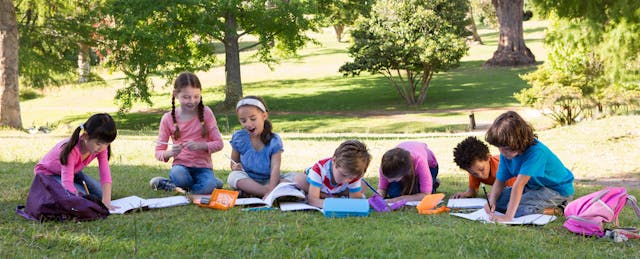It’s summer time, and the learning is not easy.
That’s in large part because the widespread staffing shortages that plagued the 2021-22 school year have stretched into summer programming, which, in many cases, relies on licensed school teachers to sign up to continue working with students.
But teachers are exhausted. They may want—even need—the extra income from summer jobs, but many are also desperate for a break after the last two-and-a-half years and trying to prioritize their mental health.
J.R. Entsminger, an elementary school principal outside of Chicago, says his district was not able to serve nearly as many children as usual with its summer program this year, and the reason boils down to staffing.
“This school year was the most challenging school year we’ve ever faced, and my staff would agree with that,” he says. “Those challenges led to some burnout. We were all very tired. I’m still tired.”
“We couldn’t get teachers to opt in” to summer school, Entsminger explains.
And it’s not just his district. Summer learning programs from coast to coast have struggled to hire the number of staff needed to operate at full capacity, leading to limited slots and even closures among programs in Maine, Connecticut, Ohio, Georgia and other states.
“This is a summer where kids can build greater confidence, greater resilience and self-esteem. This [should be] a summer of growth and learning,” says Tom Rosenberg, president and CEO of the American Camp Association, which was serving 26 million children before the pandemic. But “right now, candidly, there is not enough capacity to serve all of our young people.”
To get around this, many camps, districts and other summer learning programs have had to rethink their approach to scheduling and staffing. Some have shortened the length of the program days to a few hours, rather than six or eight. Others have broken up their programs into mini sessions so staff don’t have to commit to the full summer. Many are using federal relief funding to raise pay for staff as a way to sweeten the deal. A number have partnered with existing community programs to maximize the kids they can serve.
“Camps are trying to be creative in how they hire education professionals,” Rosenberg says. “They’re having to be more flexible.”
Yet Aaron Dworkin, CEO of the National Summer Learning Association, knows of at least one summer learning program with a waitlist of teachers. So it’s possible, he says, to make this work, even after a taxing few years in education.
“If you have a program model and no teachers want to work it,” Dworkin says, “maybe change your model.”
Striking a Balance
That summer learning program with the waitlist? It’s called Teachers in the Park, and it’s led by fourth-grade teacher Matt Hathaway in Reading, Pennsylvania.
Hathaway founded the program in 2004 to help a few of his students who wanted extra support in math and science. Since then, it’s grown to serve about 1,000 students a year from 13 school districts.
The model is delightfully simple. For a couple of hours each day, kids gather on blankets under trees in local parks and learn from a licensed school teacher. They have lessons in English language arts, math, and social-emotional learning, all in their two hours together. Typically, a child will be coming from or heading to another summer activity, such as swimming lessons, often hosted by their city’s parks and recreation department.

The schedule is meant to be light-hearted and approachable, Hathaway says. He wants to destigmatize “summer school” and the forced remediation that people associate it with. Hathaway designed Teachers in the Park to be fun.
“Kids grow like trees,” he says. “You wouldn’t bury a tree in fertilizer just because it had a couple of harsh years, even though fertilizer is good for trees. You need sunshine, water and fertilizer. If you only use fertilizer, you burn them out.”
Certainly the pre-K through fourth graders who participate in Teachers in the Park have had a couple of harsh years, but that doesn’t mean they should be inside the four walls of a school, sitting at a desk, memorizing times tables all day, Hathaway argues. They should get to play outside and socialize and enjoy summer while they learn.

“You need a nice balance of physical, emotional and academic” in summer learning, he says. “If you’re too much of any one of them, you’re not gonna get the outcomes you need.”
Teachers benefit from that balance, too.
“What teacher in their right mind wants to work all year, and then sign up to work all summer—harder than they did before?” Hathaway says.
He knows the answer to that, because he’s asked teachers what they want and what they are willing to do. That’s how Teachers in the Park landed on two hours a day as the magic number for programming.
It may seem brief, perhaps even insufficient. But Hathaway insists it is enough to help kids retain what they learned from the prior year, while preventing teachers from feeling bogged down and burned out.
“We find that a couple of hours in the morning, where they can kind of rejuvenate in the summer, is what teachers want,” he says.
Teachers like making the extra money, but also finishing by lunch time and getting to spend the remainder of their day as they please. Hence the waitlist.
Most teachers are paid for 10 hours a week, at $40 an hour, an increase from the $30 they were paid before the pandemic.
Teachers in the Park is using ESSER funds from the American Rescue Plan to support that pay bump, but has also worked with Hathaway’s district, Exeter Township, to ensure that rate can be sustained even after the federal relief dollars run out.
The American Rescue Plan includes $122 billion for K-12 education, with up to $30 billion that can be used for after-school and summer learning programs. Those funds have primarily flowed to districts, many of which are using the dollars to launch, expand or improve summer learning programs, says Dworkin of the National Summer Learning Association.
A More Inclusive Summer
Some ESSER dollars are being used to boost staff pay for summer learning programs, like with Teachers in the Park. In part, that is an attempt by programs to draw in teachers who are otherwise reticent to raise their hands for more work. But it’s also, in some cases, intended to dull the sting of rising inflation and attract a more diverse pool of applicants.
At the Thompson Island Outward Bound Education Center, located on a small island in the Boston Harbor, kids participate in free, sometimes overnight outdoor and experiential learning. At times, they’re getting schooled in STEM and social-emotional learning. Or they’re navigating the waters on a sea kayak, or setting up camp.
For most kids, it makes for a memorable summer—and is an absolute blast, says Arthur Pearson, president and CEO of the Thompson Island program. But historically, it depended on the young adult children of wealthy parents to fill positions.
In 2019, Thompson Island Outward Bound was paying staff $90 to $105 a day, which for an eight-hour day, would come out to around $11 to $13 an hour. Their instructors tended to be mostly white and male, while their students, who are able to participate in the program for free, were mostly non-white, according to Richard Atkind, vice president of administration for Thompson Island Outward Bound.
By summer of 2020, as the pandemic raged and conversations circulated about systemic racism in the U.S., Pearson and his colleagues realized they needed to pay their staff more if they hoped to make the program instructors more reflective of the students they served.
Pearson describes the previous arrangement as “more or less a poorly paid internship that you only can do, frankly, if you’ve got a safety net from your parents.” It’s not perfect now, and their work diversifying staff is not finished. But they have increased the pay to $130 a day and now provide benefits to many instructors, too.
Even still, it’s seasonal work, and the pay is less than what Amazon and Walmart offer. So while they are technically fully staffed, they are “running very thin” and “operating at the minimum levels,” Atkind says. In other words, there is little margin for error if, say, one person were to get sick or quit.
But from Pearson’s perspective, it could be much worse. He has talked to leaders of youth development programs across the country this summer and heard of some reducing slots or even canceling courses outright as late as one week before the camp was set to begin, saying, “We can’t take your kids. We just don’t have enough staff.”
“It’s brutal. It’s really hard,” he says. “So we feel fortunate.”


